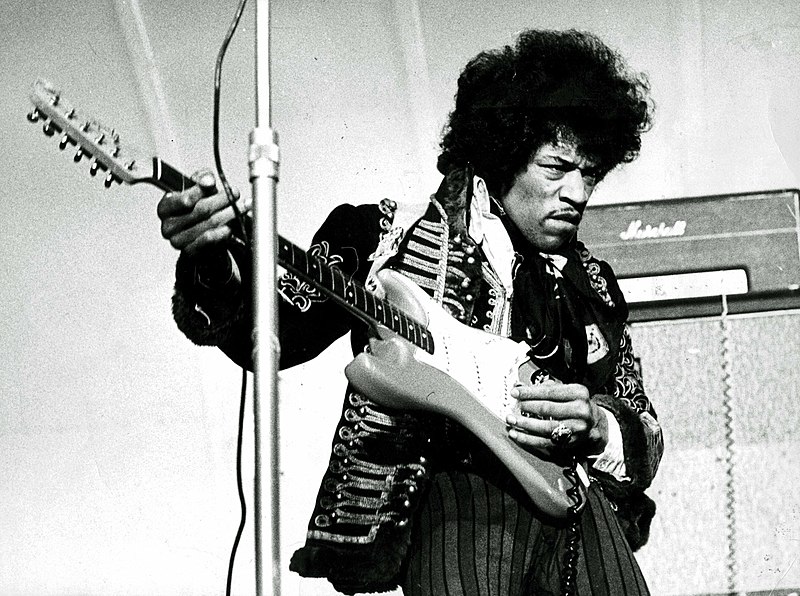Introduction
Jimi Hendrix (1942-1970) is no doubt one of the 60s music era legends. The music magazine Rolling Stone ranked him as the greatest guitarist of all time. His raw, energetic blues-influenced guitar playing has not failed to delight music audiences, whether classic rock fans or modern rock fans of the present. He first played for several acts (such as the Isley Brothers and Little Richard) before moving to the UK where he first found recognition. He only achieved fame in his homeland after his appearance at the Monterey Pop Festival in 1967. He also headlined the Woodstock Festival in 1969. Hendrix died in 1970 due to drug-related complications. More on Jimi Hendrix here in our “oldies music” article.
Early life and career
Jimi Hendrix was born John Allen Hendrix on November 27, 1942 in Seattle, Washington. Sometimes his given name was James Marshall Hendrix. His mother Lucille Jeter was only 17 when he was born. Hendrix had an unhappy and difficult childhood. She had a tempestuous relationship with Hendrix’s father, and soon left the family (Hendrix would only see his mother occasionally until her death in 1958). The couple had two more children, Jimi’s brothers Leon and Joseph. They would live in the care of their relatives and sometimes acquaintances.
Music became Jimi Hendrix’s refuge from all his difficulties. When he was 15 or 16 his father bought him an acoustic guitar. Not long after, he began to play the electric guitar. Hendrix’s earliest musical influences were rooted in blues and rock and roll.
In the late 1950s he quit school in order to do odd jobs while continuing to pursue his musical ambitions. In 1961 he was drafted and enlisted to the US Army but was soon given an honorable discharge.
Soon after his discharge from the military Hendrix continued to pursue his music career. He played as a session/backup musician for several big acts such as the Little Richard, Isley Brothers, Sam Cooke, and B.B. King, among many others. In 1965 he also formed his own band, the Jimmy James and the Blue Flames. They frequently played in Greenwich Village in New York City.
The Jimi Hendrix Experience
In late 1966 Hendrix moved to the United Kingdom after he was discovered by Linda Keith (daughter of renowned British actor and disc jockey Alan Keith). Keith, in turn, informed Chas Chandler, the bassist of the British rock group The Animals. Chandler was interested in Hendrix and soon became his manager.
Hendrix soon went to London upon Chandler’s encouragement. It was there where Hendrix formed the Jimi Hendrix Experience with Noel Redding (bass) and Mitch Mitchell (drums). If you are interested to learn more about his drummer, Mitch Mitchell, you may read our post, “How Did Mitch Mitchell Revolutionize Rock Drumming Yet Remain Underrated?”
Hendrix soon became popular in the British music scene, building up a strong following who included the Beatles and Eric Clapton. For a time, Hendrix and Clapton were seen by the press as well as fans as guitar rivals.
They group’s first single “Hey Joe” was a big hit in the UK, peaking at #6. Follow-up singles “Purple Haze” and “The Wind Cries Mary’ also became big British smashes at #3 and #6 respectively. They embarked on a tour that supported their first LP Are You Experienced. In those performances audiences were delighted by Hendrix’s electrifying, innovative and experimental guitar playing.
American stardom and subsequent legend
Hendrix’s rise to fame as a rock star came quickly, and that continued in the United States when he performed at the Monterey Pop Festival in 1967. In late 1967 he released Axis: Bold as Love which became successful on the charts — #3 on the Billboard 200 and #6 R&B albums chart.
In 1968 Hendrix scored once more with his third and final album in his lifetime, Electric Ladyland. It went all the way to #1 on the Billboard 200 album chart in 1968. It also was Hendrix’s most commercially successful album in his career. The album’s singles “All Along the Watchtower” (#20 US pop, #5 UK) and “Voodoo Chile” (#1 UK) did quite well but more than the chart performances they became just a few of the many quintessential Jimi Hendrix songs.
Hendrix’s stardom was even more magnified when he headlined the Woodstock Festival in 1969 and the Isle of Wight Festival in 1970. By then Hendrix had become the highest-paid solo rock artist in the world. It was also during this period that Jimi Hendrix was called as one of the best guitarists of the 1960s. To know more about other iconic 1960s guitarists, you can check our list of The 10 Best Guitarists of the 1960s.
Death and legacy
Like many other rock stars of his generation, Hendrix was also addicted to drugs and alcohol which eventually led to his untimely demise. He died in London on September 18, 1970, aged only 27. His death was ruled as accidental, having been caused by a drug-related asphyxia.
Although Hendrix was gone too soon, he otherwise left an enduring mark in the rock history. Even decades after his death, his legend never fades but it even has grown bigger and stronger. Rock music fans and aspiring musicians in the following generations have come to acknowledge his genius and influence.
Hendrix popularized the amplifier feedback and the wah-wah pedal, among many other things, into mainstream music. His innovations led the Rock and Roll Hall of Fame to declare him as “arguably the greatest instrumentalist in the history of rock music.” Hendrix was inducted into the Rock and Roll Hall of Fame in 1992 as a member of the Jimi Hendrix Experience.

